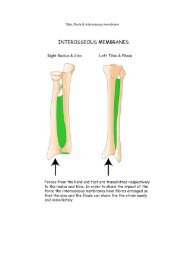GSM 11.11 version 6.2.0 - TTFN Smart card pages
GSM 11.11 version 6.2.0 - TTFN Smart card pages
GSM 11.11 version 6.2.0 - TTFN Smart card pages
- No tags were found...
Create successful ePaper yourself
Turn your PDF publications into a flip-book with our unique Google optimized e-Paper software.
(<strong>GSM</strong> <strong>11.11</strong> <strong>version</strong> <strong>6.2.0</strong> Release 1997)15TS 100 977 V<strong>6.2.0</strong> (1999-05)If the SIM clock is already stopped and is not restarted, the ME is allowed to deactivate all the contacts in any order,provided that all signals reach low level before Vcc leaves high level. If the SIM clock is already stopped and isrestarted before the deactivation sequence, then the deactivation sequence specified in ISO/IEC 7816-3 [26] subclause5.4 shall be followed.When Vpp is connected to Vcc, as allowed by <strong>GSM</strong> (see clause 5), then Vpp will be activated and deactivated with Vcc,at the time of the Vcc activation/deactivation, as given in the sequences of ISO/IEC 7816-3 [26] subclauses 5.1 and 5.4.The voltage level of Vcc, used by <strong>GSM</strong>, differs from that specified in ISO/IEC 7816-3 [26]. Vcc is powered when it hasa value between 4,5 V and 5,5 V.4.3.3 Inactive contactsThe voltages on contacts C1, C2, C3, C6 and C7 of the ME shall be between 0 and ± 0,4 volts referenced to ground (C5)when the ME is switched off with the power source connected to the ME. The measurement equipment shall have aresistance of 50 kohms when measuring the voltage on C2, C3, C6 and C7. The resistance shall be 10 kohms whenmeasuring the voltage on C1.4.3.4 Contact pressureThe contact pressure shall be large enough to ensure reliable and continuous contact (e.g. to overcome oxidisation andto prevent interruption caused by vibration). The radius of any curvature of the contacting elements shall be greater thanor equal to 0,8 mm over the contact area.Under no circumstances may a contact force be greater than 0,5 N per contact.Care shall be taken to avoid undue point pressure to the area of the SIM opposite to the contact area. Otherwise this maydamage the components within the SIM.4.4 PrecedenceFor Mobile Equipment, which accepts both an ID-1 SIM and a Plug-in SIM, the ID-1 SIM shall take precedence overthe Plug-in SIM (see <strong>GSM</strong> 02.17 [6]).4.5 Static ProtectionConsidering that the SIM is a CMOS device, the ME manufacturer shall take adequate precautions (in addition to theprotection diodes inherent in the SIM) to safeguard the ME, SIM and SIM/ME interface from static discharges at alltimes, and particularly during SIM insertion into the ME.5 Electronic signals and transmission protocolsElectronic signals and transmission protocols shall be in accordance with ISO/IEC 7816-3 [26] unless specifiedotherwise. The following additional requirements shall be applied to ensure proper operation in the <strong>GSM</strong> environment.The choice of the transmission protocol(s), to be used to communicate between the SIM and the ME, shall at leastinclude that specified and denoted by T=0 in ISO/IEC 7816-3 [26].The values given in the tables hereafter are derived from ISO/IEC 7816-3 [26], subclause 4.2 with the followingconsiderations:- V OH and V OL always refer to the device (ME or SIM) which is driving the interface. V IH and V IL always refer tothe device (ME or SIM) which is operating as a receiver on the interface.- This convention is different to the one used in ISO/IEC 7816-3 [26], which specifically defines an ICC for whichits current conventions apply. The following clauses define the specific core requirements for the SIM, whichprovide also the basis for Type Approval. For each state (V OH , V IH , V IL and V OL ) a positive current is defined asflowing out of the entity (ME or SIM) in that state.ETSI








